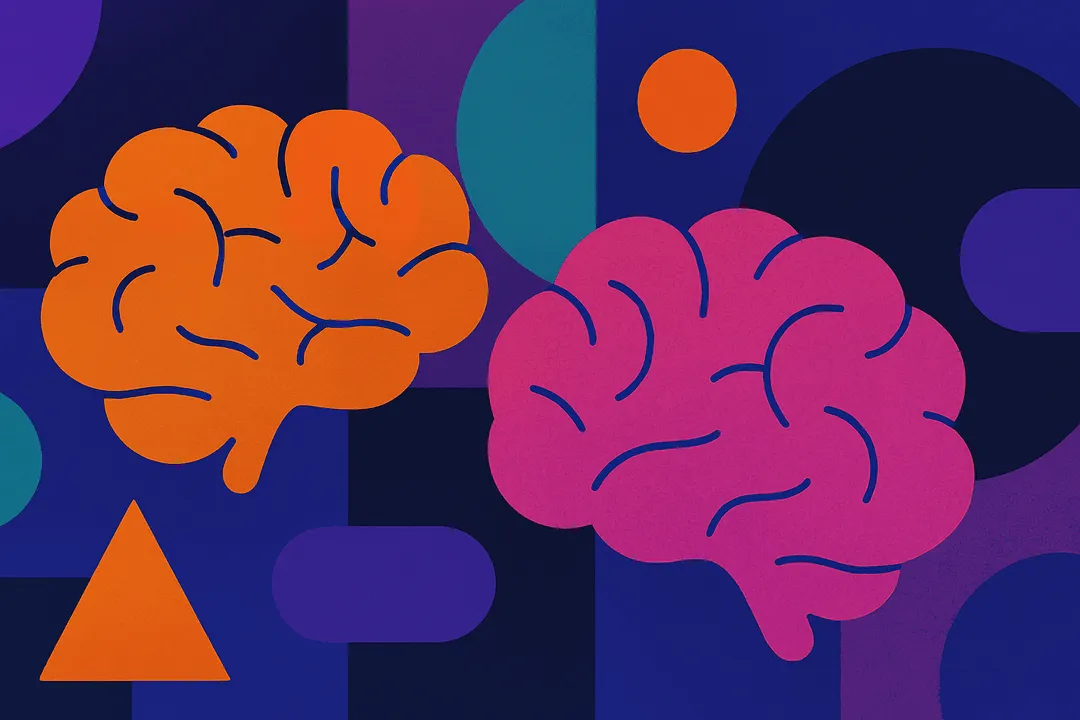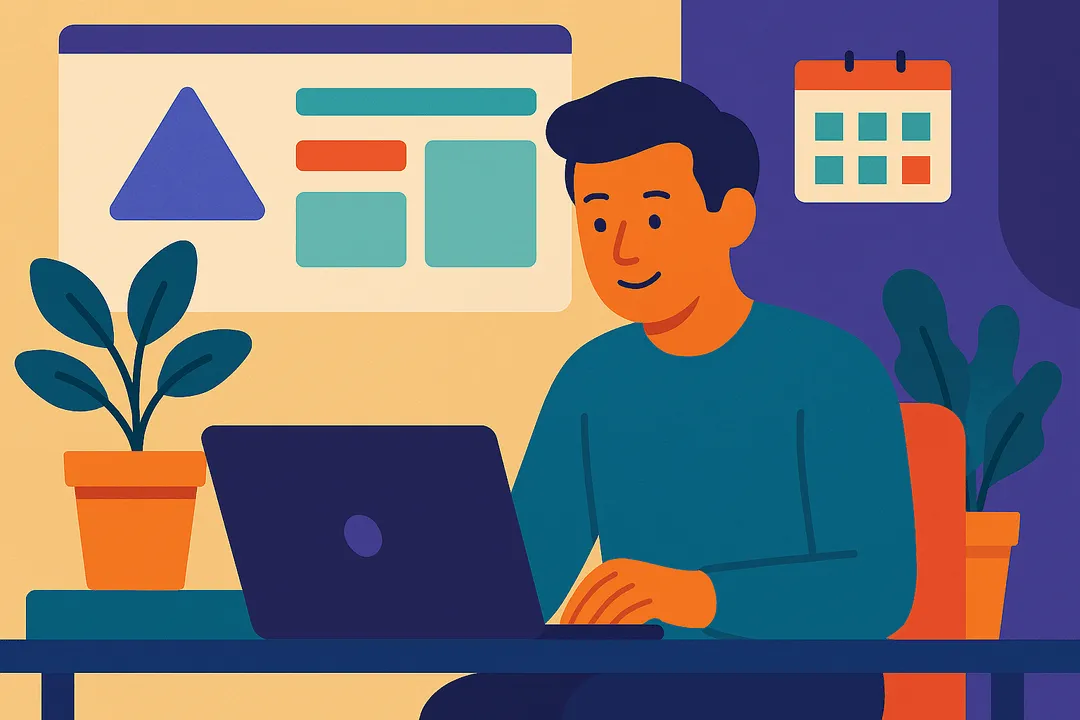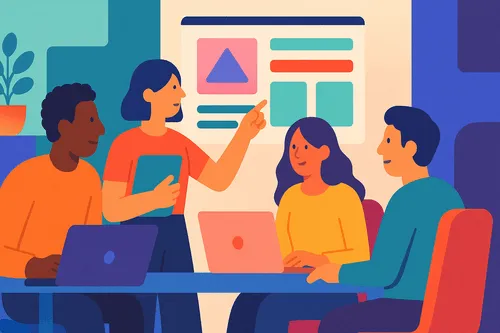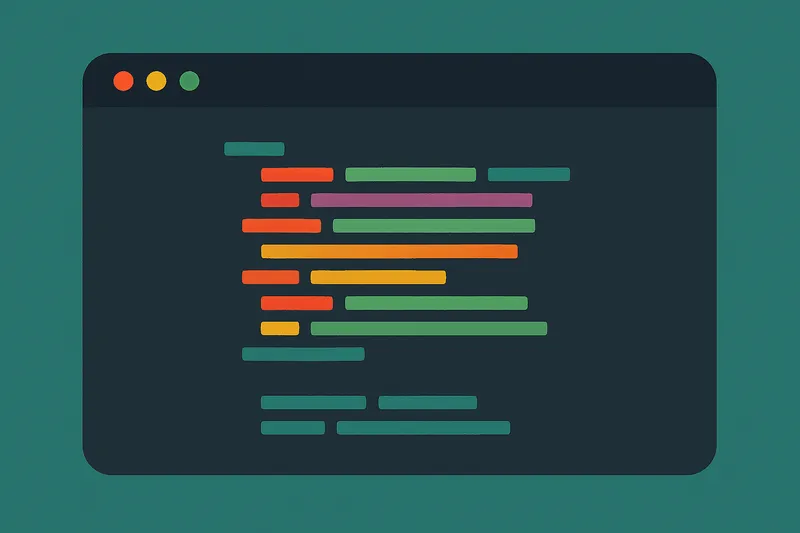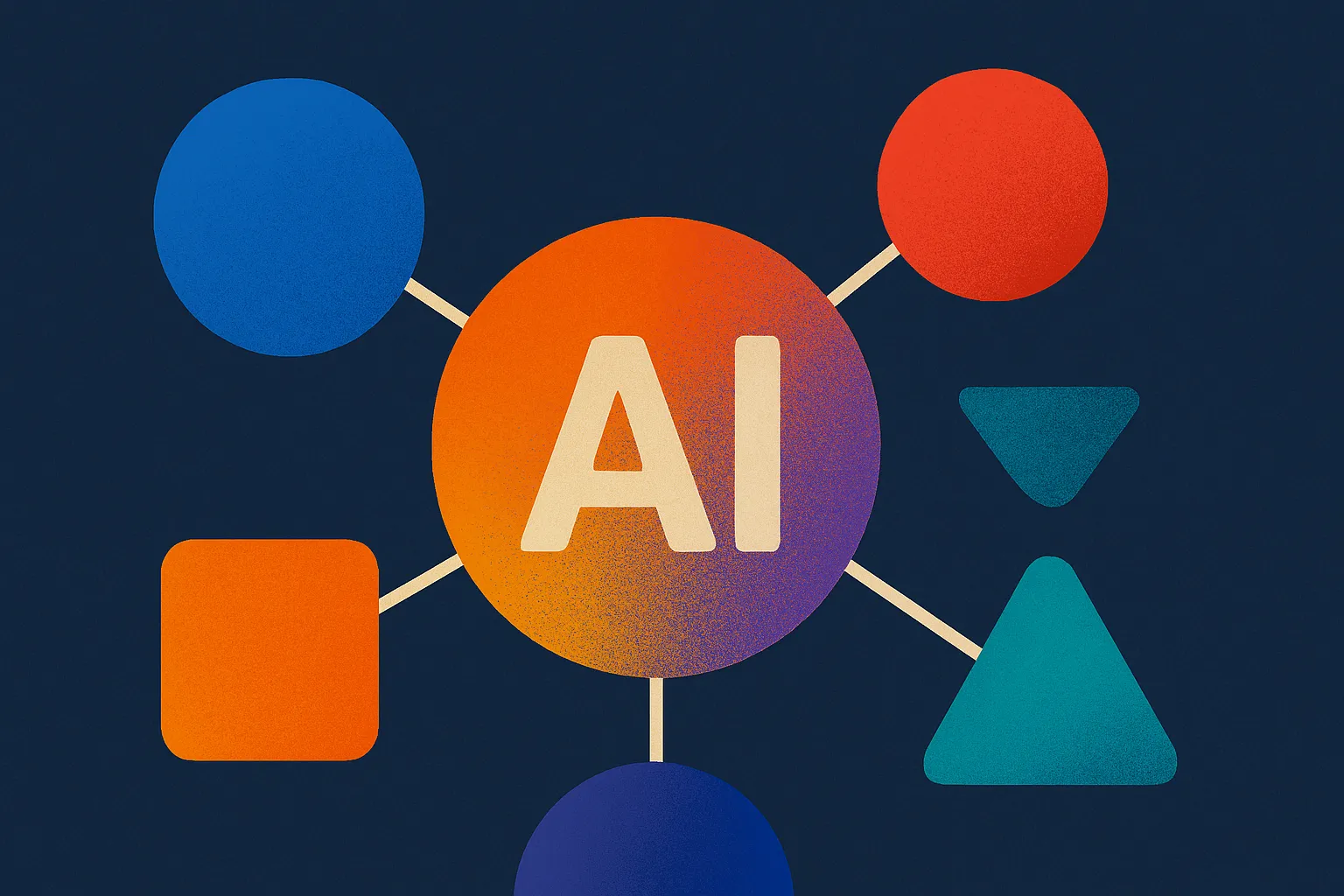

The Future of Web Design and AI: A Glimpse into 2025

Stop me if you’ve heard this before: “AI is going to replace designers.” You’ve probably seen the headlines, read the articles, and maybe even had your own doubts. As we head into 2025, the truth is far more exciting—and less scary—than the fearmongers would have you believe.
Sure, artificial intelligence (AI) is transforming web design, but not by taking away jobs. Instead, AI is becoming a powerful tool that helps you design faster, smarter, and more creatively than ever before. Imagine AI tools handling the repetitive tasks, freeing you up to focus on the ideas and creativity that make your work unique.
In this blog, you’ll learn about the major trends shaping the future of web design. From AI-driven personalization to the resurgence of vintage design elements, I’ll break down how you can leverage these innovations to enhance your own designs. By the end, you’ll feel empowered to embrace AI, not as a replacement, but as your new creative partner.
The Rise of AI in Web Design
AI in web design isn’t about replacing creativity—it's about enhancing it. Imagine having a design assistant that can instantly generate layout ideas, suggest color schemes, or even optimize the user experience based on real-time data. That’s the potential AI brings to the table.
For many designers, AI sounds like it will automate creativity out of the process. But in reality, it’s doing the opposite. By automating tedious tasks like resizing images, generating responsive layouts, or suggesting accessibility improvements, AI is giving designers more time and mental space to focus on what they do best: creating engaging, human-centered designs.
AI as a Creative Partner, Not a Replacement
Consider AI as your co-pilot. Tools like Figma or Adobe Sensei are already making design collaboration easier by using AI to predict actions, streamline workflows, and reduce time spent on repetitive tasks. For example, instead of spending hours tweaking the same visual elements for different screen sizes, AI can instantly create adaptive designs, leaving you free to refine the overall look and feel of the site.
By reducing manual effort, AI allows designers to put their energy into innovation and strategy. This means you can spend more time refining the emotional impact of a website, brainstorming new ideas, or creating more immersive user experiences. The idea isn’t to replace you—it’s to give you tools that make your designs smarter and more dynamic.
Getting Started with AI in Web Design
If you’re new to AI-driven design, it’s easier than you might think to get started. Tools like Uizard or Figma’s AI features are great for beginners, offering user-friendly platforms that generate wireframes, layouts, and even full design concepts based on simple inputs. These tools allow you to experiment with ideas quickly, see how AI can streamline your design process, and get a sense of where the technology can add value.
The key is to experiment. Try incorporating AI into your next project and see how it frees you up to focus on the creative decisions that only you can make.
Enhanced Creativity and Interactive Experiences
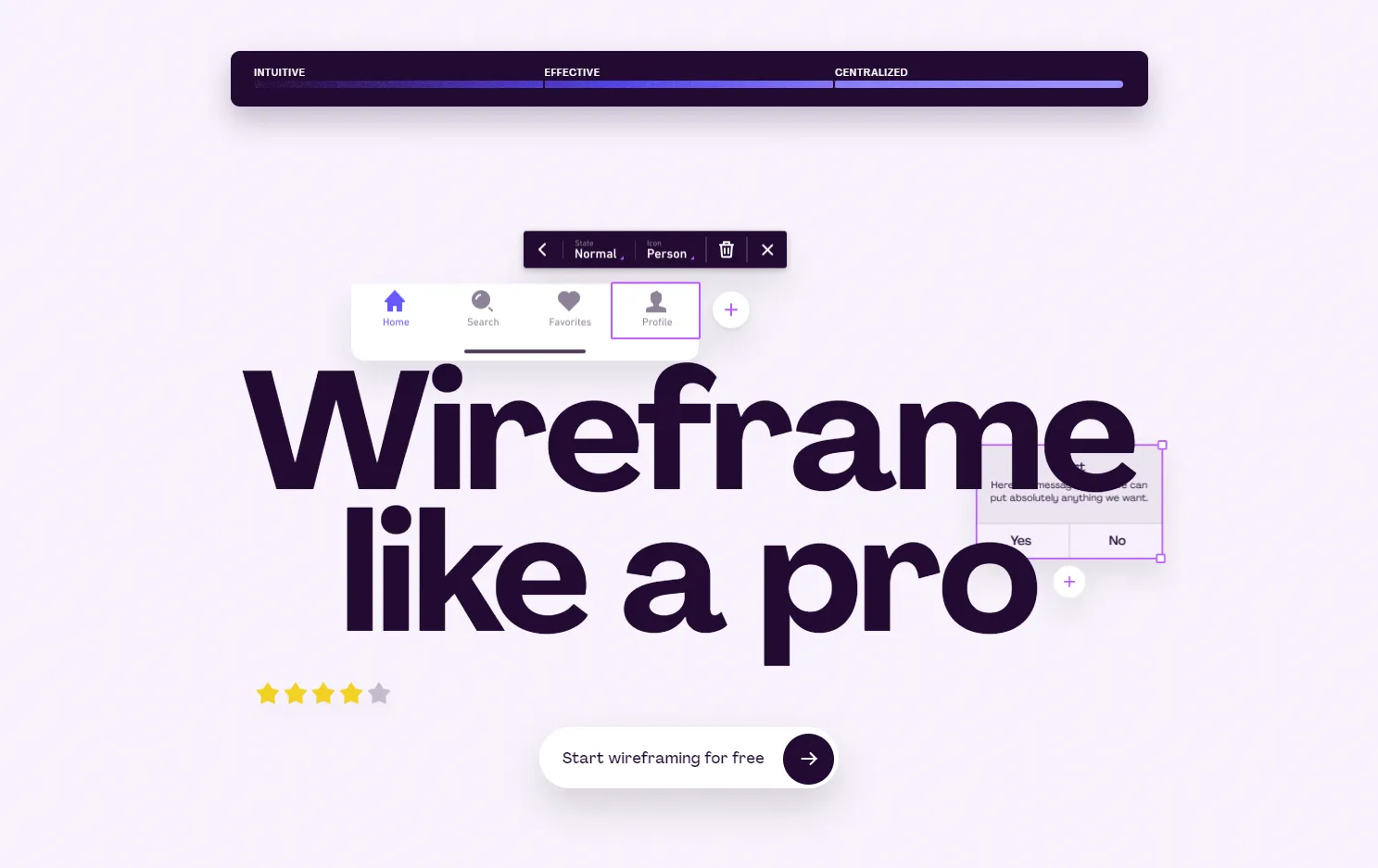
As AI continues to evolve, it’s opening up new avenues for creativity that were once only possible with advanced technical skills or large design teams. One of the most exciting shifts is the ability to create highly interactive, visually captivating websites that push boundaries—without sacrificing performance or user experience.
Whimsical Wireframes and Rich Compositions
The days of flat, minimalist web design are starting to fade as we see a resurgence of more complex, vibrant compositions. Designers are embracing bold, dynamic layouts with intricate textures and vibrant color schemes. With the support of AI, these elements aren’t just thrown together—they’re optimized in real-time for performance, accessibility, and user interaction.
For example, AI-powered tools can analyze user behavior and automatically tweak elements like typography, image placement, and even color contrast to improve engagement. This gives you the freedom to explore more creative, experimental designs while ensuring that usability isn’t compromised.
Imagine designing a homepage where the color palette subtly shifts to match user preferences, or typography that adapts to screen brightness—these are no longer futuristic concepts, but achievable with AI.
The Emergence of 3D and Immersive Design
One of the most exciting trends AI is driving forward is the incorporation of 3D elements into web design. 3D graphics used to be resource-heavy and complicated to integrate, but today’s AI tools make it easier to add depth and realism to your website.
Think about online stores or portfolios where users can interact with 3D models of products or designs. AI not only simplifies the creation of these elements but can also optimize them in real time for smooth performance across different devices.
This is particularly powerful when combined with augmented reality (AR) and virtual reality (VR). With AI helping to optimize 3D environments, designers can now create more immersive, realistic user experiences that go beyond the typical 2D web interface.
For example, Three.js and Spline are two AI-powered tools that are democratizing 3D design for the web, allowing designers to integrate rich, interactive elements without needing to become experts in 3D rendering. This makes your designs more engaging, turning passive viewers into active participants in the web experience.
Dynamic, Data-Driven Design
AI isn’t just about creating visually stunning elements—it’s also about making them smarter. Through AI-driven tools, designers can craft dynamic, data-driven designs that adapt to individual user behaviors and preferences. Think of it as real-time personalization on steroids.
For instance, with AI, your website could automatically adjust its layout, colors, and even call-to-action buttons based on user data. If a user typically interacts with certain types of content or prefers a specific layout, AI can learn these preferences and adapt the website accordingly. This creates a highly personalized experience for every visitor without requiring constant manual updates.
By blending creativity with data, you’re not just designing a beautiful website—you’re designing a living website that evolves with your users. This level of interaction deepens engagement and helps create a lasting connection between your brand and your audience.
AI-Driven Personalization and Efficiency

Personalization used to be a luxury feature reserved for big companies with large budgets. But thanks to AI, it’s becoming standard practice—accessible to designers of all levels. AI’s ability to analyze user data in real time and tailor experiences accordingly is one of its most powerful features. It’s no longer just about creating a static website but crafting one that evolves with the user.
AI-Generated Designs: Smarter, Faster, Customizable
AI-generated designs are a game-changer for web designers. Instead of spending countless hours manually creating each element of a site, AI tools can now generate entire layouts, graphics, and even color schemes based on user data or simple inputs from the designer.
For example, platforms like Wix ADI (Artificial Design Intelligence) and Firedrop can generate fully functional websites by asking a few basic questions about your preferences and needs. These tools aren’t just for beginners—they provide a strong foundation for experienced designers, allowing you to focus on refining the details that make your website stand out.
This ability to streamline the design process means faster turnaround times, reduced costs, and the freedom to spend more time on the creative aspects of a project. Whether you’re a freelancer juggling multiple clients or part of a large design team, AI can handle much of the heavy lifting, leaving you more room to innovate.
Personalized UX/UI with AI: Making Every User Feel Seen
AI is revolutionizing the way we approach user experience (UX) and user interface (UI) design. Rather than designing for a general audience, AI enables you to personalize every aspect of a site for individual users. It can dynamically change a site’s layout, messaging, or even product recommendations based on a user’s past behavior, preferences, and interactions.
For instance, AI-powered recommendation systems—like those used by Amazon or Netflix—analyze user activity and suggest content or products tailored to their interests. On a smaller scale, imagine a website that adjusts its tone, design, or layout based on whether the user is a returning customer, a new visitor, or even someone browsing at a specific time of day.
Tools like Personyze and Dynamic Yield allow designers to create highly customized experiences without needing to manually code every variation. You can set rules and triggers based on user data, and AI will take care of the rest, adjusting content, images, or layouts in real-time to suit each visitor. This level of personalization not only boosts user engagement but also creates a deeper sense of connection between users and the site.
Efficiency Through Automation: Let AI Do the Repetitive Tasks
While personalization is about tailoring the experience, AI’s role in efficiency is equally transformative. Tasks that once took hours—like testing different layouts, optimizing for multiple devices, or ensuring accessibility standards are met—can now be handled automatically by AI.
For example, Adobe Sensei integrates AI into Adobe’s Creative Cloud suite, automating routine tasks such as cropping, generating responsive designs, and even suggesting changes to improve a design’s visual impact. This means you can spend less time on the technical side of things and more time on the creative process.
Automated tools can also continuously optimize a website's performance by running A/B tests on everything from color schemes to button placement, learning in real-time which variations perform best. AI doesn’t just make web design faster—it makes it smarter.
The AI-Powered Future of UX/UI Testing
Gone are the days of manually conducting endless user testing sessions. AI can now analyze user interactions across a website to detect pain points, predict user behavior, and offer solutions for improving the overall experience.
For example, Google’s AutoML Vision can analyze vast amounts of user interaction data and identify design elements that cause friction or confusion. AI tools can suggest changes based on how users navigate through your site, helping you continually refine the UX/UI without requiring constant human input.
By leveraging AI for testing, designers can gain insights that were previously impossible to gather without extensive resources. This not only saves time but also allows you to refine designs based on real-world data, ensuring that your website meets user needs at every stage.
Revival of Vintage Design Elements
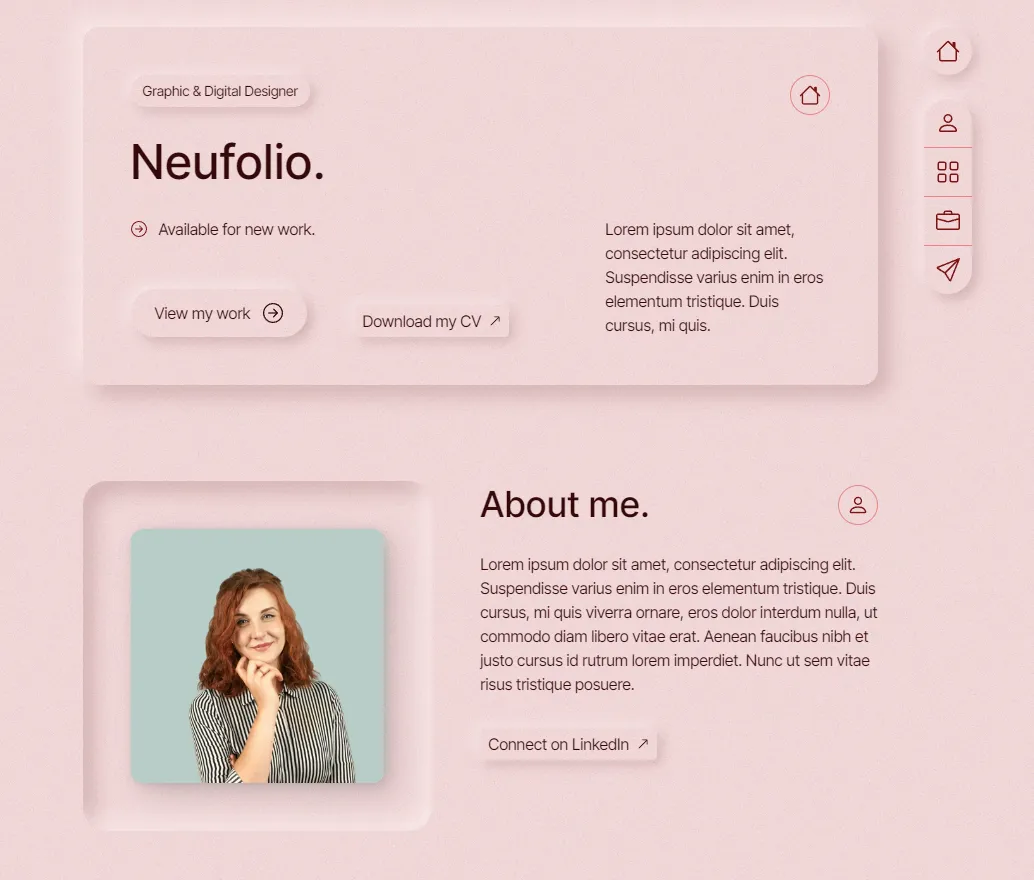
The Revival of Vintage Design Elements
In an age of rapid technological advancement, it’s ironic that some of the most exciting design trends for 2024 are rooted in the past. Vintage design elements, once considered outdated, are making a comeback—thanks in large part to the creative power of AI. By blending retro aesthetics with cutting-edge technology, designers are creating websites that feel both familiar and fresh, connecting with users on an emotional level.
Skeuomorphism: A Return to Tangibility
Remember when digital design mimicked real-world objects, like buttons that looked like actual buttons? That was skeuomorphism, and after years of flat, minimalist design dominating the web, it’s making a subtle return.
Skeuomorphism brings back the idea of using familiar, real-world elements in web design to make digital experiences feel more tangible. And with AI, designers are able to take this concept to the next level. AI tools can help automatically generate realistic textures, shadows, and depth effects that enhance the physical feel of digital objects.
For example, AI can analyze light and shadow patterns to create realistic drop shadows that mimic how objects would appear in the physical world. This is especially useful in e-commerce, where skeuomorphic design can make products feel more touchable and real, providing a richer experience for online shoppers.
Tools like Cinema 4D and Blender, when combined with AI-driven rendering engines, allow designers to create these realistic, immersive elements without needing an in-depth knowledge of 3D modelling. This revival of skeuomorphism is a great way to inject personality into websites while keeping them engaging and interactive.
Kinetic Typography: Words in Motion
Text is no longer static, and kinetic typography—the art of animated text—is gaining popularity as a way to grab attention and convey messages dynamically. But here’s where AI steps in: instead of manually animating each element, AI tools can automate this process, ensuring that the animations are smooth, responsive, and perfectly timed.
AI can automatically generate text animations that adjust to different screen sizes, ensuring that typography is both eye-catching and accessible. Whether it's subtle fades, bold movements, or responsive resizing, AI allows designers to add a layer of dynamic energy to text that would otherwise remain static.
Tools like Motion.ai or Adobe After Effects (which includes AI features) can automate these animations, letting designers focus more on the creative direction of the message rather than the technical execution. Whether it’s a bold headline sliding into view or text that subtly shifts to reflect user interactions, kinetic typography is becoming a powerful tool for storytelling in web design.
Blending Retro with Modern: Vintage Meets Technology
One of the most interesting aspects of the revival of vintage design is how seamlessly it blends with modern technology. By combining nostalgic aesthetics like skeuomorphism and kinetic typography with AI, designers are able to create websites that evoke a sense of familiarity while offering a futuristic user experience.
For instance, a website might use vintage-inspired fonts, textures, and 3D buttons, but layer on AI-powered animations or personalization to keep the experience fresh and modern. It’s this combination of old and new that creates a richer, more immersive experience for users, tapping into nostalgia while leveraging the capabilities of today’s technology.
Additionally, AI tools are enabling designers to experiment with these retro elements without sacrificing performance or accessibility. Automated optimizations can ensure that even the most complex designs load quickly and function smoothly, making it easier for designers to embrace these vintage styles without worrying about the technical limitations of the past.
4. Future-Forward Design Techniques
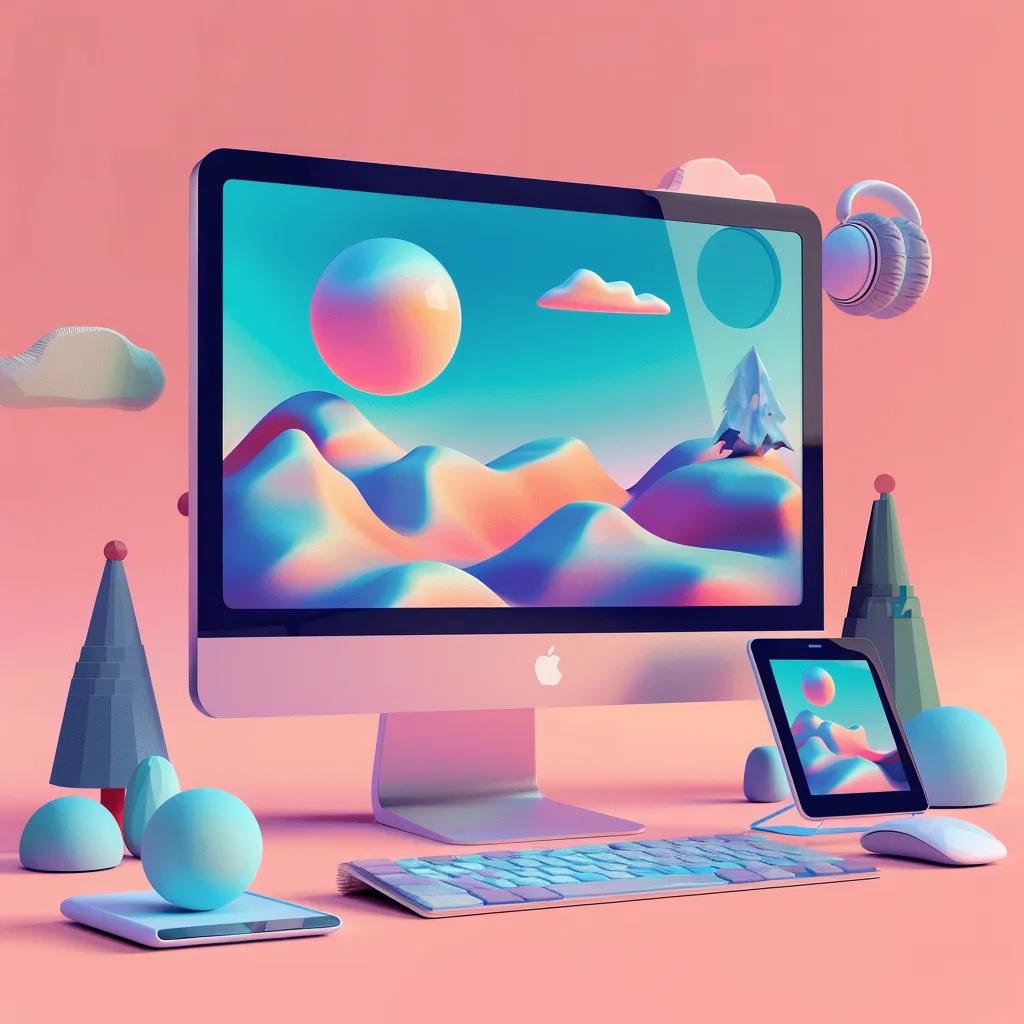
As AI continues to evolve, it’s not just making current trends better—it’s giving rise to entirely new ways of thinking about design. Two of the most exciting innovations at the intersection of AI and web design are micro-interactions and generative AI. These tools are pushing web experiences to a new level, where every detail, no matter how small, can have a significant impact on user engagement.
Micro-Interactions: Small Details, Big Impact
Micro-interactions are those subtle, often overlooked design elements that enhance user engagement. These could be a button that changes color when hovered over, a notification bubble that subtly vibrates, or a progress bar that animates as a user completes a task. Though small, these interactions play a huge role in creating a seamless, enjoyable user experience.
With AI, these micro-interactions are becoming more personalized and context-aware. AI-driven tools can analyze user behavior and adapt micro-interactions to fit individual preferences, making them more meaningful and less intrusive.
For instance, AI can adjust the speed or intensity of a hover animation based on how quickly a user navigates through a site. If the user tends to move fast, micro-interactions can be made more subtle to avoid slowing them down. Conversely, for users who take their time, micro-interactions can become more dynamic to guide them through the content.
Tools like Framer and Origami Studio use AI to streamline the creation of micro-interactions, allowing designers to implement these small but crucial features without needing to dive deep into code. These tools also help ensure that micro-interactions enhance, rather than distract from, the overall user experience.
Generative AI: From Data to Design
Generative AI is revolutionizing the way designers create web content by transforming raw data into fully-formed designs. Essentially, generative AI can take a set of parameters—such as user preferences, brand guidelines, or even abstract concepts—and create a design that meets those specifications.
The beauty of generative AI is that it offers multi-modal creativity, blending inputs from different sources (like text, image, or even audio) to generate cohesive designs. This technology is especially useful in scenarios where content needs to be refreshed frequently or when users demand unique experiences each time they visit a site.
For example, a website using generative AI could automatically redesign itself based on the user’s preferences or browsing history. If a user frequently reads blog posts about minimalism, the AI could generate a minimalist version of the site for that particular user. For others, the AI might create a more vibrant, colorful layout based on their past interactions.
Generative AI is also streamlining the content creation process. Tools like RunwayML and Artbreeder enable designers to experiment with different design options quickly, generating multiple layouts or graphic variations based on simple inputs. This means that designers can focus on higher-level creativity, while AI takes care of generating the basic frameworks or assets.
AI-Powered Responsive Design: The Next Level of Customization
One of the biggest challenges in web design has always been ensuring that sites look great across different devices. Traditionally, this has required creating multiple versions of the same design—one for desktops, one for tablets, and one for mobile devices.
AI is making this process more efficient and precise. With AI-powered responsive design, layouts and elements can automatically adjust to any screen size or orientation without the need for manual intervention. For example, AI tools like The Grid and Uizard can generate responsive designs that adapt in real-time to different devices, all while keeping the core aesthetic and functionality intact.
The result? Websites that not only look great on every screen but also provide personalized experiences tailored to each user’s device and browsing habits. This level of responsiveness is crucial in an era where users access websites from a wide variety of devices, from smartphones and tablets to smart TVs and even wearables.
The Future of AI-Driven Design: A Collaborative Process
As AI continues to integrate with web design, it’s clear that the future isn’t about AI replacing human designers. Instead, it’s about collaboration—AI handling the technical, data-driven aspects while humans focus on creativity, strategy, and emotional connection. Generative AI can provide a multitude of options, but it’s still up to the designer to choose the one that resonates with the brand’s identity and the user’s needs.
This partnership between AI and human creativity is what’s pushing web design forward into uncharted territory. It’s giving designers the freedom to explore new ideas, create more interactive experiences, and deliver content faster than ever before—all while maintaining a high level of personalization and engagement.
The Democratization of Web Design through AI
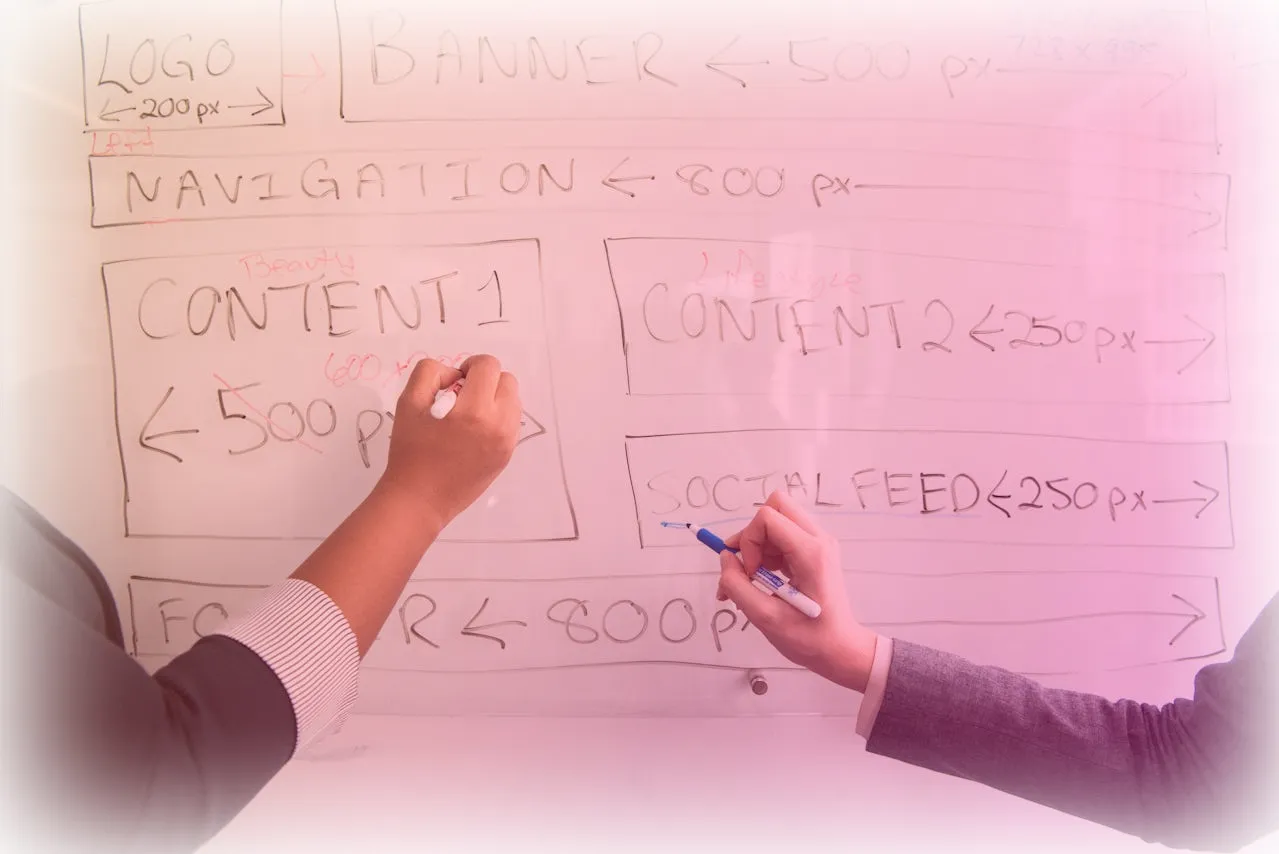
For years, web design has been a skill set that required extensive technical knowledge of coding, design principles, and user experience. But as AI technology advances, it’s breaking down those barriers and making web design accessible to people from all backgrounds. Whether you’re a seasoned designer or a small business owner with no design experience, AI is levelling the playing field, allowing anyone to create functional, aesthetically pleasing websites with minimal effort.
Automated Web Design: Turning Ideas into Reality
AI-powered web design platforms like Wix ADI, Bookmark AiDA, and The Grid are taking the design process and automating it. These tools enable users to input basic information—such as the type of website, design preferences, and desired functionality—and the AI handles the rest. It can generate everything from layouts to color schemes, offering fully functional websites in minutes.
What’s remarkable about AI-driven platforms is that they cater to both beginners and professionals. For someone with little design experience, AI provides an easy, step-by-step process to get a site up and running without needing to write a single line of code. For more advanced users, these platforms offer customization options, allowing designers to tweak and refine AI-generated designs to match their unique vision.
This democratization of web design means that more businesses, individuals, and organizations can establish a digital presence without having to invest heavily in professional web development services. The shift is already visible: a small business owner can create an e-commerce site, or an aspiring blogger can launch a personal site in a fraction of the time and cost it would have taken just a few years ago.
No-Code and Low-Code Platforms: Design for All
The rise of no-code and low-code platforms is further driving the accessibility of web design. These platforms, which often integrate AI, allow users to create complex websites and applications through drag-and-drop interfaces rather than requiring extensive coding knowledge.
Webflow, Bubble, and Carrd are prime examples of platforms that make designing and building websites easier, thanks to AI that helps streamline everything from layout suggestions to responsive design adjustments. With AI handling much of the back-end complexity, users are free to focus on the visual and creative aspects, even if they have no technical background.
What’s particularly empowering about no-code platforms is that they open up opportunities for entrepreneurs, small business owners, and creatives who might not have the budget to hire a developer. It’s a shift from needing technical expertise to simply having a good idea and the willingness to explore AI-powered design tools.
The Role of AI in Supporting Freelancers and Small Teams
Freelancers and small design teams are also benefiting greatly from AI’s impact on web design. AI tools are helping them scale their operations and take on more projects by automating many of the time-consuming aspects of design. For example, AI can handle repetitive tasks like image optimization, layout adjustments, and even generating wireframes, giving designers more time to focus on client relationships and creative problem-solving.
In many ways, AI is acting as a digital assistant for freelancers and small agencies, helping them deliver professional-grade websites faster and more efficiently. Tools like Uizard allow designers to rapidly sketch out wireframes, while Squarespace’s AI-driven design engine ensures that layouts are responsive and visually appealing without requiring hours of tweaking.
For freelance designers, this means they can take on more clients and deliver projects in a fraction of the time, all while maintaining the quality of their work. And for clients, it means faster turnaround times, lower costs, and more personalized websites that reflect their individual brand or message.
AI’s Role in Empowering Creativity, Not Replacing It
While AI-driven design tools are making the web more accessible to everyone, it’s important to remember that AI doesn’t replace creativity—it empowers it. By automating technical tasks and simplifying workflows, AI gives designers more room to explore new ideas, take creative risks, and focus on the elements that matter most.
This democratization of design doesn’t mean that professionals are becoming obsolete. Instead, it’s opening up a world where designers can collaborate with AI to create even more innovative and engaging websites. It’s a shift from focusing on the technical details to thinking more strategically about how to connect with audiences, craft compelling user journeys, and push the boundaries of what’s possible online.
Opportunities for Non-Designers: Expanding Who Can Build
AI in web design is also opening the door for individuals who aren’t traditionally part of the design world—business owners, marketers, and even content creators. With tools that simplify the design process, anyone with a vision can turn their ideas into reality.
For example, a small business owner can use AI to create a custom site that reflects their brand, without needing to hire a web designer. Marketers can leverage AI-powered tools to build landing pages that convert, while content creators can design visually appealing blogs and portfolios without relying on outside help. This democratization of web design is transforming not just who can create, but also how fast and cost-effectively it can be done.
Wrap-up
As we look towards 2025, one thing is clear: AI is going to stick around.
So, what’s next? Don’t wait for the future to arrive—embrace it. Start exploring AI-driven tools in your own web design projects, experiment with new techniques, and see how AI can help you create meaningful digital experiences that resonate with your audience. Whether it’s incorporating AI-generated designs, enhancing your user interface with personalized micro-interactions, or diving into the world of 3D design, the possibilities are endless.
More recent insights







